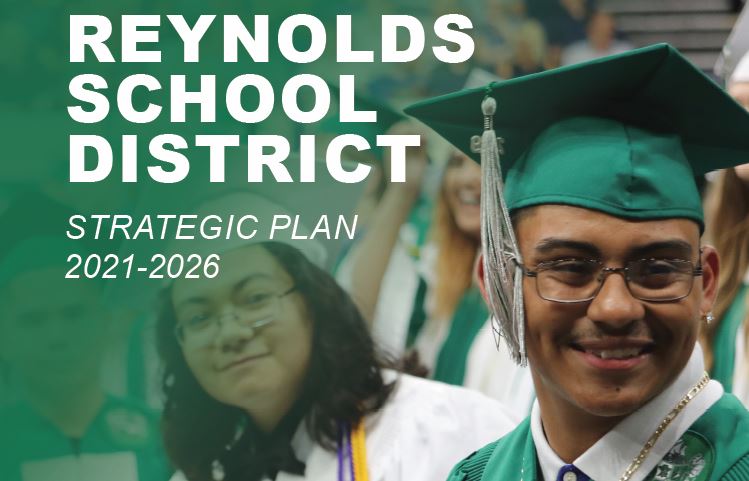Strategic Plan & Results Dashboard
Please click on each arrow to expand each section. To download the 2021-2026 Reynolds School District Strategic Plan, click HERE
Creating a Vision for Reynolds School District
During the 2019-2020 school year students, families, staff, partners, and community members collaborated to define Reynolds School District’s vision.
400+stakeholders shared input |
18focus groups |
3community meetings |
6Steering Committee meetings |
What we heard:
Strengths
- Supportive community
- Diversity of the student population and community
- Strong relationships and support from community partners
- Hope and excitement for the future
- Diversity of the Board of Education
Areas to Focus On
- Lifting the voices of students, staff, and families in developing and refining policies and procedures
- Equity as the foundation for decision-making
- Mental health supports for staff and students
- Culturally responsive curriculum and instruction
- Aligning professional learning, policies, procedures, and practices throughout the system
Throughout the process, stakeholders were asked to view the district through the lens of the Board of Education’s Core Commitments and Beliefs:
|
|
|
|
|
|
The process resulted in the Steering Committee and Cabinet identifying four major Goal Topic Areas that were vetted through the Board’s Core Commitments and Beliefs, which are now the Four Pillars of the strategic plan.
The four major Goal Topic Areas are:
- Marginalized Students
- Culturally Responsive Instruction
- Student and Staff Wellness
- Professional Development
The Cabinet collaborated with staff representing the Reynolds Administrator Group (RAA), the Reynolds Education Association (REA), and the Oregon School Employee Association (OSEA) to form four Goal Topic Teams charged with reviewing and aligning the Goal Topics to Board Goals and Core Commitments, establish goals and timelines for each area, and identify tangible evidence for the completion of each goal.
We thank everyone involved for your dedication and support as we do this important work for the future of our district!
Mission & Vision
MISSION:
We lead with equity to educate and support all students to graduate with the skills and confidence to thrive.
VISION:
As a community, we prepare lifelong learners to achieve their full potential in a complex and interconnected world.
Goal Descriptions
Specific results dashboards are within each goal topic by clicking on each arrow below. For all results, see below.
Goal 1: Marginalized Students
In order to give voice to our marginalized* populations, we will remove barriers, hold high academic expectations, and elicit and honor all voices.
*In Reynolds, we define "marginalized" as those students and families who are furthest from justice and those who have been historically silenced in our school system. Our marginalized population is identified as our Black and Brown students. We believe that if we address the disparities faced by our Black and Brown students, it will positively impact other groups facing systemic barriers.
Goals
Elevate Voice: We will create opportunities that allow voices that have been historically marginalized to be honored and elevated.
Remove Barriers: We will take action to identify and remove internal barriers (and provide tools to overcome external barriers) so that marginalized students have just and equitable access to a high-quality education.
Communication: We are committed to truly listen and create timely/efficient communication systems.
Improve the academic and social experience for Black students and families in RSD.
Pillar Alignment:



Metrics
METRIC 1: Elevate Student Voice
- No less than three times per year, schools and district-level departments will use a combination of surveys, empathy interviews*, input sessions and community meetings to measure the level of equitable participation as well as the overall satisfaction of students and families. Disaggregate for Black students and families. (The ultimate goal is to ensure that there is a true representation of the school/district community in decision making.)
RESULTS: Student Collaboration & Interpersonal Skills
RESULTS: Attendance Rate (District-Wide, School Level, and by Ethnicity)
RESULTS: Family Perceptions around Parent & Community Involvement
METRIC 2: Remove Barriers
- District departments or schools will identify the top three barriers to the goals on an annual basis.
- RSD will analyze the data from graduation rates, acceptance rates to 4-year universities/trade programs, and percentage rates of identified students in Talented and Gifted Programs of historically marginalized students and disaggregated for Black Students.
RESULTS: Internal Perception Barriers Around Student Achievement
RESULTS: Student Achievement Data - STAR Early Literacy, Reading, and Mathematics
RESULTS: 3rd Grade Literacy District Improvement SMART Goals on STAR-Reading
RESULTS: 4-Year Graduation Rate
METRIC 3: Communication
- At the conclusion of each outreach opportunity, RSD schools and or departments will use input sessions, surveys, and/or community feedback to identify internal and external barriers to student and community communication.
- Annual equity progress review to address barriers identified by families.
RESULTS: Family Perceptions Around Communication
RESULTS: Staff Perceptions Around Communication
ACTION STEPS |
LEADER |
EVIDENCE |
|---|---|---|
ELEVATE VOICE |
||
|
Adhering to the metrics listed, each school and District-level department will be responsible for including an action plan in their SIP or DIP, directly related to Marginalized students.
|
ACADEMICS COMMUNICATIONS & COMMUNITY RELATIONS |
|
REMOVE BARRIERS |
||
|
Each school and District-level department will be responsible for including an action plan in their SIP or DIP, directly related to Marginalized students.
|
SCHOOLS ACADEMICS COMMUNICATIONS & COMMUNITY RELATIONS |
|
COMMUNICATION |
||
|
Each school and District-level department will be responsible for including an action plan in their SIP or DIP, directly related to Marginalized students.
|
SCHOOLS ACADEMICS COMMUNICATIONS & COMMUNITY RELATIONS |
|
Goal 2: Culturally Responsive Teaching
We will interrupt bias and microaggression in instructional practices.
Goals
Share decision making with all stakeholders.
Honor student ways of being and showing knowledge: student voice and choice.
Eliminate control/compliance as proof of learning.
Curate curriculum.
Pillar Alignment:




Metrics
METRIC 1: Listening
-
Annual improvement in stakeholder survey and listening session participation rates that mirror student demographics.
RESULTS: CEE Survey Student Participation Demographics
METRIC 2: Elevate Student Voice
- Annual improvement in student survey data about voice and choice.
RESULTS: Student Perceptions Around Voice and Choice
METRIC 3: Equitable Grading
- Annual progress toward equitable grading practices at each grade level.
RESULTS: Attendance Rate by Ethnicity & Percentage of Chronically Absent by Ethnicity
METRIC 4: Culturally Responsive Teaching
- Annual progress curating curriculum toward culturally responsive teaching across all grades and subject areas.
ACTION STEPS |
LEADER |
EVIDENCE |
|---|---|---|
SHARED DECISION MAKING WITH ALL STAKEHOLDERS |
||
|
Establish shared definitions for Culturally Responsive Teaching. |
ACADEMICS |
|
|
Establish a baseline. Do our stakeholders currently view our teaching practices as culturally responsive? |
|
|
|
Establish a process to ask this every year to track year over year data; include in the CEE survey. |
|
|
|
Establish a process to annually listen and learn "live" with stakeholder groups to hear the actual voices of our community, with an equity lens on who our stakeholders are. |
|
|
|
Establish student exit survey to determine why students "leave" school. |
|
|
HONOR STUDENT WAYS OF BEING AND SHOWING KNOWLEDGE: STUDENT VOICE AND CHOICE |
||
|
Establish a baseline of student perception of their current level of voice and choice. |
ACADEMICS |
|
|
Increase student voice and choice in their educational experience. |
|
|
|
Establish a way to measure student voice and choice year over year. |
|
|
|
Ensure addition of electives or choice, especially equity in PE, art, music offerings in elementary. |
|
|
ELIMINATE CONTROL/ COMPLIANCE AS PROOF OF LEARNING |
||
|
Establish equitable grading practices and accompanying communication strategy to families. |
ACADEMICS |
|
|
Separate "will" from "skill" in feedback. |
|
|
|
Stop issuing summative grades for formative assessment. |
|
|
|
Establish clear success criteria (i.e. rubrics) for summative grading across a variety of assessment formats. |
|
|
CURATE CURRICULUM |
||
|
Add ethnic studies coursework at all grade levels. |
ACADEMICS |
|
|
Supplement adopted curricular materials with culturally responsive texts. |
|
|
|
Ensure curricular materials present multiple perspectives on content. |
|
|
|
Implement social justice, multicultural education, and ethnic studies in curricular content and enhance cross-curricular approach. |
|
|
Goal 3: Student and Staff Wellness
We will promote a healthy learning and working environment that provides students and staff with the skills, social support, and environmental reinforcement they need to adopt healthy long-term behaviors.
Goals
Develop and implement a robust District-adopted wellness policy that focuses on physical, mental-emotional, and social health for students, family, and staff.
Pillar Alignment:


Metrics
METRIC 1: Draft plan presented to Board for adoption.
METRIC 2: Revision of related board policies.
METRIC 3: Development of a wellness policy guide.
METRIC 4: Evidence of ongoing meeting of wellness committee.
RESULTS: Mental Health - Who would you go to at your school for help?
RESULTS: Staff Perceptions Around Health and Wellness
ACTION STEPS |
LEADER |
EVIDENCE |
|---|---|---|
|
Form standing Wellness Committees at all levels – Elementary, Secondary, & Staff Wellness Committees. |
STUDENT & FAMILY SERVICES COMMUNICATIONS & COMMUNITY RELATIONS |
|
|
Review/revise Board policies and federal and state guidelines related to student and staff wellness. Review and offer recommendations to the Policy Review Committee. |
|
|
|
Revise Board policies related to student and staff wellness. |
|
|
|
With stakeholder input, draft a Wellness Policy Guide aligned to the revised Board policies related to student and staff wellness. |
|
|
|
Over the next five years, periodically survey student, staff, and family (parent/guardian) stakeholder groups and review Oregon Healthy Kids Survey results. |
|
|
|
Ensure Wellness Committee meets quarterly every year. |
|
|
|
Build an action plan to commit to improving student, family, and staff wellness. Make other and online resources available. |
|
Goal 4: Professional Development
We will offer continuous learning opportunities from onboarding to retirement for all staff to develop the skills, knowledge, and confidence to accelerate student outcomes.
Goals
Improving the quality of professional development for all staff while eliminating systems of racism and oppression to become a high performing, culturally responsive school district.
Pillar Alignment:




Metrics
METRIC 1: Voluntary staff retention - less retirement and reduction in force.
METRIC 2: Measure the quality of delivery and content of professional development by using a standardized feedback form across departments.
METRIC 3: Results from the annual community and staff RSD perception survey (CEE Survey).
METRIC 4: Measure RSD recruitment of applicants, hiring, and retention of candidates of color.
RESULTS: Staff Perceptions Around Focused Professional Development
ACTION STEPS |
LEADER |
EVIDENCE |
|---|---|---|
|
Build a rubric for culturally responsive practices. |
ACADEMICS |
|
|
Utilize PLCs, staff meetings, and conferences to measure implementation of the PD offerings.
|
SCHOOLS |
|
|
Develop and implement an effective coaching and mentoring model that provides ongoing support to staff. |
HUMAN CAPITAL MANAGEMENT ACADEMICS |
|
|
Design a professional development tracking form for all staff in every department that outlines a professional development pathway focused on equity, safety, instructional practices, and organizational culture. Create a PD Map by position designed for all staff from start date to retirement differentiated by skill for all positions. |
HUMAN CAPITAL MANAGEMENT |
|
|
SIP/DIP plans have a clearly articulated implementation plan for professional development specific to culturally responsive practices. |
SCHOOLS ACADEMICS |
|
|
Articulate professional development standards. |
HUMAN CAPITAL MANAGEMENT ACADEMICS |
|
|
Design a standardized feedback form to measure the quality of delivery and content of all PD |
HUMAN CAPITAL MANAGEMENT |
|
|
Departments and schools will examine and derive SIP/ DIP action steps from community and staff perception survey results annually. |
SCHOOLS ACADEMICS |
|
|
All staff who exit RSD will complete a feedback form focused on organizational improvement. |
HUMAN CAPITAL MANAGEMENT |
|
|
Review existing policies, resources and practices with a culturally responsive lens to eliminate systems of racism and oppression in areas including, but not limited to: Recruitment, Selection/Hiring, Evaluation, and Coaching. |
HUMAN CAPITAL MANAGEMENT |
|
All Results
Funding (including SIA and ESSER)
Many of the plans and initiatives in the Strategic Plan are made possible by state and federal funding. Click the links below to learn more about these funding sources.





